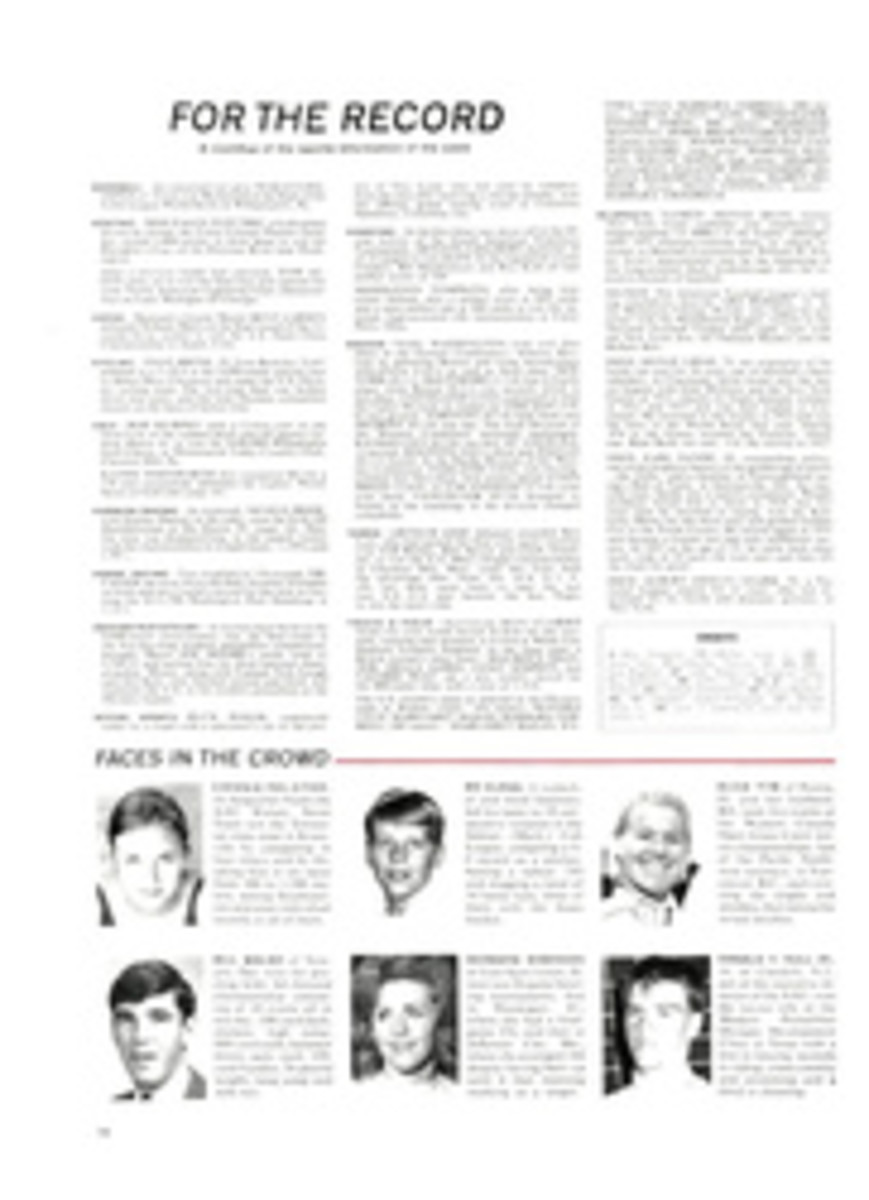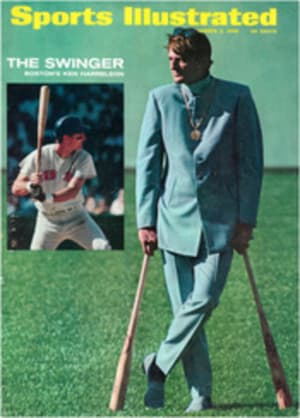
BY ANY OTHER NAME...
The Green Bay Packers, chafed a bit from an unaccustomed two straight defeats, roused themselves from an understandable lethargy to put the upstart Dallas Cowboys in their place in the Cotton Bowl last Saturday night, 31-27. It was a cheering victory for quiet Phil Bengtson, who drives the Packers with an obviously looser rein than did Vincent Lombardi, and it served notice to the experts who had begun to write off the Packers that there has been little change in the club.
The two teams which met on this humid August evening bore only a slight resemblance to the clubs that will meet again in the Cotton Bowl in October and possibly a third time for the NFL championship. The Packers may win in October, and once more in December, but they will beat a different Cowboy team and will field a different club while doing it. For this was what Commissioner Pete Rozelle prefers to call a preseason game and what, in franker days, was called an exhibition game. It provided a good excuse for some 72,000 Dallas fans to get out of their houses and into the open air on a hot night and it was entertaining and exciting, but as a measure of the relative strengths of these clubs it was all but meaningless.
The fans, to be sure, did not come in expectation of seeing a replay of the classic championship contests these teams have put on in the last two years. It was made abundantly clear in the pre-game publicity that Jerry Rhome, Dallas' third-string quarterback, would play all of the second half or share it with Craig Morton, the Dallas No. 2. Dallas fans over the years have learned to expect Tom Landry to experiment with his forces in the preseason games, and that is precisely what he did. So did Bengtson, who used Bart Starr for the first quarter, then gave Zeke Bratkowski an opportunity to sharpen himself for the season to come. The game was entertainment and it had moments of real excitement—as when Travis Williams broke off the right side of the substitute Dallas line and fled 75 yards for a touchdown, and again late in the game when Pete Gent outjumped a couple of Green Bay defenders to score for the Cowboys. But the two varsities appeared only for about a quarter apiece. The Green Bay starters beat the Dallas starters 7-0 before the testing program for rookies and substitutes began.
There is, of course, nothing wrong with this, and it is unlikely that any of the fans in the Cotton Bowl felt cheated—nor should they have. But it is a bit ridiculous when the league insists on calling these contests preseason games to give them a surface importance not justified by the facts.
Like most exhibition games, this one proved only what the coach or owner wanted it to prove. The games played before the regular season starts were once honestly called exhibitions and played as laboratory exercises to determine which combination of ingredients would be the most effective once the teams began to play for keeps. Now, because of the tremendous increase in costs for all pro football clubs, these games have come to mean necessary added income. Already this year preseason games have drawn 1.6 million, and attendance seems certain to surpass last year's record of 2,001,547. For some teams victory in these games has also become important.
In 1967, for instance, New Orleans, one of the two or three worst football teams in the NFL and playing in its first season, managed to win five of its six preseason games because Tom Fears, the head coach, had been instructed to do so. He brought the club into camp at San Diego a week early, worked his players mercilessly and met the more relaxed, less intense older teams with personnel that had reached midseason form in early August. Fears knew very well that his club would run out of gas early, but by the time it began to falter New Orleans fans had taken their heroes to their hearts and the franchise was off and winging.
This year the Saints are going through what is in effect an agonizing reappraisal. The old men with a season or two left in their aging muscles will begin to slide quickly downhill, and the young ones, who should have been given a decent interval in which to acclimatize themselves to the rigors of the pro football climate, will not be able to handle their responsibilities.
Watching the Saints during the exhibition season in 1967, the unsophisticated observer might have felt that this was a phenomenal young team with a real chance of placing high in its division. Nothing, of course, could have been farther from the truth. It was a typical expansion team, capable of winning two or three games on Sundays on which it caught a weak team minus key players due to injury and unimpressed to the point of somnolence. The Saints won three "for keeps" games last year. If they win that many this season Fears will have performed a minor miracle. They came to camp a week later than in 1967 and they have not mounted an all-out campaign to win exhibitions so they will be better conditioned for the regular season. They will have settled into the pattern of weak clubs moving up with the help of rookies.
This is another reason why exhibition games are not a valid yardstick by which to measure true competence. The set teams—Green Bay and Dallas, for example—must seriously look at only two or three rookies a year. The young teams with hordes of eager rookies must, on the other hand, examine them carefully, hoping to avoid the grievous mistake the Pittsburgh Steelers made 13 years ago when they let John Unitas go in order to keep Ted Marchibroda. This, of course, is an extreme example, but mistakes of the same kind on a lesser order can slow the development of a club by years.
Teams like the Saints, the Minnesota Vikings or the Cincinnati Bengals cannot be evaluated until they have advanced three or four games into the regular season and are playing with units that have had a reasonable time in which to learn each other's first names. During the exhibition season they may test two or three players at nearly every position; they may lose by horrendous scores while Paul Brown, say, scans the capabilities of a free agent from Saspamco Tech. They may lose by almost as horrendous scores during the season when the Saspamco Tech star has been replaced by a late reject from the San Diego Chargers, but it will no longer be because Paul, or whoever the coach might be, is forced into playing inferior personnel simply to discover if it is inferior.
This, of course, is the true value of exhibitions to the clubs. The money should be a secondary consideration. The games should be used as they once were, to winnow the wheat from the chaff and to prepare for the serious business ahead. In this context the games are well worth watching, and equally well worth the ticket prices charged for them. When you add to this the fact that many of them are played for worthwhile charities, it becomes obvious that no other rationale is needed.
The problem with two teams like the Packers and the Cowboys is almost the precise opposite of the one confronting the have-nots. This is especially true of a veteran team such as Green Bay, a team which has in the last three years achieved every glory available in pro football and in the process earned an extra $60,000 or $70,000 per player. Successful pro clubs are, for the most part, veteran pro clubs. Many of the players have advanced to the middle age of their careers and if they want to be strong on those days when they get the highest profit per play—the regular season—they must husband their energies now.
Green Bay, coming into this game, had lost two games in a row, to the New York Giants and the Chicago Bears. The Packers had borne only a rather remote resemblance to the club that had demolished Los Angeles in the conference playoff, squeezed by Dallas in the NFL championship game and humiliated Oakland in the Super Bowl. The personnel was the same, but the motivation was much less. For a team that has played a game for $15,000 per player, an exhibition game in which the individual reward is paid out in dimes and quarters is hard to get up for.
Before this game in Dallas the Packers sat in the welcome cool of the air-conditioned lobby of the Executive Inn and studied the pleasing contours of Dallas girls while they contemplated the chore of playing the Cowboys in the 90° heat of the Cotton Bowl. They approached the game with something less than total enthusiasm.
"We got to win this one and we'll give it all we can," one veteran said. "We don't want to get in the habit of losing. But I've been around a long time and I'm over 30 and I know how long the season is. I'll be trying tonight, but I know I've got to save something for the season. This game doesn't move me a step closer to that $25,000 you get for winning the championship and the Super Bowl. It just makes sense to make sure you're ready for the games that count."
Henry Jordan, the All-Pro defensive tackle who had missed two games with a bad back suffered in the All-Star Game, sprawled on a couch. "The only way it doesn't hurt is when I lie flat on my back with my legs up in the air," he said. "And you can't play much tackle in this league in that position. But I got to test it tonight. I got to play to find out if I can."
He played, and played very well, sore back and all. He played probably more minutes than most of the Green Bay veterans because he needed the work after missing two games and because he had to give the back a thorough test.
He passed the test and so did the Packers as a whole. They used the game to rediscover their mastery of Dallas, then to season the younger players and determine how much value their rookies might be to them later. Not many of the rookies will be on the roster when the season starts, nor will many of the Dallas rookies be around when the Cowboys start playing for real.
Meanwhile, it was fun watching them. With clubs plentifully sprinkled with youngsters, the Packers and Cowboys played with considerable abandon, made mistakes and came up with wild plays. All of these factors helped Dallas make a game of it in the closing minutes with two long touchdowns.
It was entertaining—but it was not the equivalent of a league game. It was only an exhibition, no matter what the commissioner cares to call it.
THREE PHOTOS
WALTER IOOSE JR.
Packer Coach Phil Bengtson, for one, treated the game as a true exhibition, giving equal time to starters like Donny Anderson (44) and proven substitutes such as Zeke Bratkowski (12) and breakaway runner Travis Williams.
PHOTO
WALTER IOOSE JR.
Although touchdowns like Donny Anderson's were for show and the heat was fearful, 72,000 fans left their air-conditioned homes to watch.

